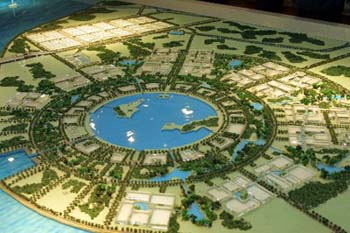Shanghai aims to inject some 36 billion yuan (US$4.5 billion) in
investment this year to develop the 300-square-kilometer Lingang
New City, a vice mayor said at a press conference in Shanghai on
Wednesday.

The model of
the Lingang New City, Shanghai. |
Of the total investment, 22.5 billion yuan (US$2.8 billion) will be
used to build the basic infrastructure of Lingang, which is
expected to accommodate up to 800,000 people when completed in
2020, Yang Xiong, the vice mayor of Shanghai, said.
The main aim of the high-profile press conference held at the
Shanghai International Convention Center was to entice domestic and
overseas enterprises to invest in Lingang, strategically located
near Shanghai Pudong International Airport and Yangshan deepwater
port.
Developers are gunning for a total of 120 billion yuan (US$14.95
billion) in investments by 2010, Yang said. "Lingang New City is
not a general development zone, and it's different from the two
other new cities of Songjiang and Jiading. It is a modern city that
will be supported by strong industries, and will be a key link in
the operations of Shanghai's two main commerce checkpoints."
Lingang will be built on an island at the entrance of Hangzhou
Bay, connected to the main city center by Donghai Bridge. About
27.5 kilometers from the city's Luchaogang area in Nanhui District,
Lingang is poised to play an important part in the Northeast Asia
shipping industry, particularly when the Yangshan port becomes
fully operational later this year.
According to a report in Shanghai Daily, the handling
capacity of Yangshan port is about 200,000 Twenty-foot Equivalent
Units (TEUs) a month.
Lingang will boast capabilities in five types of transportation
including shipping, air, inland shipping, and highway and railway,
conditions ideal for the development of a multi-modal logistics
specialization.
The city will be divided into five functional parts: the main
city area, heavy equipment industry area, logistics area, main
industry area and mixed-use area. Preferential policies will apply,
and there are plans to include free trade zones and export
processing zones. The city will also serve as a platform for six
industrial manufacturing bases: automobiles, heavy equipment,
logistics equipment, aviation equipment, and photoelectric
equipment.
Project planners have projected the city's value-added potential
to be 23.5 billion yuan (US$2.93 billion) by 2010, industrial
output value at 50 billion yuan (US$6.23 billion), and financial
revenue at 3 billion (US$373 million).
The first phase construction of seven primary and secondary
municipal roads and 24 bridges is complete. Those roads stretch a
total of 36 kilometers.
"The general structure of the city should be formed by 2010. The
main city area will house the financial, business, education,
travel, leisure and residential sectors. The initial residential
population will be 350,000 and the developed area will measure 66
square kilometers," according to Liu Jiaping, the vice director of
Shanghai Lingang New City Administrative Committee.
Cooperation agreements worth US$200 million were signed with
foreign companies including Maersk Logistics and Sulzer Metco.
Domestic companies such as China Ocean Shipping Company, China
Shipping Logistics Co., Ltd., Shanghai Electric Group Company Ltd.
also signed agreements with Lingang New City for projects worth 10
billion yuan (US$1.24 billion).
The new city committee aims to make Lingang New City the new
Shanghai economy springboard. Lingang is the most significant
portion of Shanghai's general urban planning system, codenamed
"1966," which means 1 central city, 9 new cities, 60 towns and 600
key villages.
(China.org.cn by Zhang Rui, March 31, 2006)